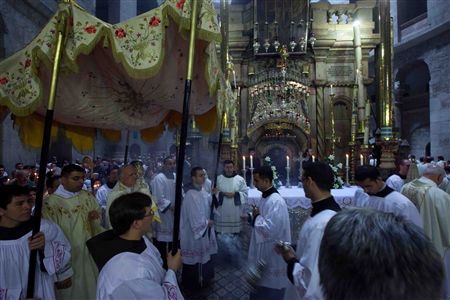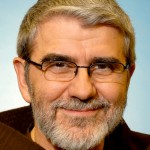Celebrating "Corpus Christi" in Jerusalem
"Despite being in a centuries-old structure,
one can imagine the hillside tombs near the rock of Golgotha, and the stone rolled back"
~
The Feast of the Body and Blood of Christ (Corpus Christi, in earlier times) was celebrated in the Church of the Holy Sepulchre, in Jerusalem, on June 4. Having just arrived for (a one-month stay in the Holy Land, I was jet-lagged but ready to join the friars in the celebration, which included a solemn entrance by the Latin Patriarch, Archbishop Fouad Twal, Morning Prayer, Eucharist, and a solemn procession around the “Edicule,” the shrine over the Tomb of Jesus.
The Franciscans, by tradition and the rules of the status quo (the historic, unwritten body of practice within the Church of the Holy Sepulchre by the Christian Churches who have rights there), escort the Patriarch from his residence to the church. This procession is led by two pairs of kawass, men in historic Ottoman garb, leading the way and beating the ground with batons. With the help of Israeli police, they clear the way through the streets, through the souk (market), and into the ancient church, usually through lines of pilgrims held back by the police.

The Feast of Corpus Christi in Jerusalem
The priest-concelebrants, like myself, have already gone ahead of time to vest in an assembly line in the friars’ sacristy. Albs, stoles, chasubles are handed out by student-friars, who serve in various roles in the liturgies in the church. Armed with a rather thick worship aid, just for the feast, primarily in Latin, we are led by masters of ceremonies to places in the friars’ chapel. This chapel commemorates the appearance of Jesus to his mother Mary. Unlike the rest of the ancient Church of the Holy Sepulchre, this chapel has modern appointments—sculpture, tabernacle, Stations of the Cross.
The Patriarch comes to the chapel after his entrance to vest—we get to watch him remove one set of clerical vestments (not his purple cassock!) and put on another set. Then we make our way out to the Tomb of Jesus, where the morning’s liturgy will unfold.
On Thursday morning, the timing was perfect for a rare sight—the sunlight streaming from high windows down to the entrance of the Edicule, where and altar was set up on a portable wooden floor, covered with a carpet. The beauty of the moment reminded one of the morning of the resurrection. Despite being in a centuries-old structure, one can imagine the hillside tombs near the rock of Golgotha, and the stone rolled back.
Chant and Latin prayers are buried deep themselves in someone who grew up “pre-Vatican II.” The Gregorian notation for the music, the melodies of some of the more common parts of the Mass and other hymns is not hard to follow. “Like riding a bike,” it comes back, as a friend of mine noted. Underneath the music and the poetry, there is prayer.
Of course, all of this is unfolding in a setting that is far different from the worship most Catholics are used to. We are in a shrine. Pilgrims and less-devout tourists are crowding at the perimeter of the liturgies. Greek, Armenian, Syrian and Coptic priests are standing nearby as well. (There are rules in the status quo about who may pray when and where. They’re watching to see that we obey the rules. Our Father Athanasius Macora, friar-liaison for the status quo, is doing the same—to see that we are free to make use of our allotted time and space.)
It’s difficult at times to detach from all of the externals. Cameras and tablets, occasional inappropriate dress, noise from groups unaware that a liturgy is happening—these can be distractions. But there are also pilgrims who have come to pray with us. And, over all, the awesome sense that one is here, where the “mystery of faith” took place.
On a feast day which commemorates the Eucharist, we are celebrating it in between the place of Jesus’ death, and the place of his resurrection. These two mysteries meet at the altar. There’s a lot to reflect upon, while one is trying to follow along in the Latin prayers. One is a pilgrim here, and a pilgrim’s task is to pray for those at home—I carry my family and friends with me to this holy place.
The Patriarch (who is Palestinian) gave a homily in Italian, reflecting on the Eucharist, and recalling Pope Francis’ own prayer in this very spot a year ago. The Patriarch mentioned the divisions among Christians and the hopes for unity. I could not help but also think of his own people, who are suffering greatly these days here in the Holy Land.
The liturgy also had its shortcomings. Because many of the texts come from the medieval liturgy, the focus is more on “worship” of the Blessed Sacrament, and less on the wider meaning of Eucharist, which is to transform God’s People into Christ’s Body—to serve in the world. One of my colleagues remarked on this later in the day. He reminded me of St. Augustine’s comment that we are present there on the altar, in our own offering.
~
So now, if you want to understand the body of Christ,
listen to the Apostle Paul speaking to the faithful:
"You are the body of Christ, member for member."
[1 Cor. 12.27]
If you, therefore, are Christ's body and members,
it is your own mystery that is placed on the Lord's table!
It is your own mystery that you are receiving!
You are saying "Amen" to what you are:
your response is a personal signature, affirming your faith.
(Sermon 272)
~
The Eucharistic Prayer always prays that the Spirit will change all of us into the Body of Christ, sign of unity and reconciliation—and as Pope Francis says, instruments of mercy.
Many older Catholics are familiar with the “Corpus Christi” procession. In past times, there would be a procession through a town or city to altars set up in various places, with Benediction. Here, in the Church of the Holy Sepulchre, that custom survives.
After Mass, the concelebrants and other ministers processed three times around the Edicule. The participants light candles, hold books, and try to walk and sing, all at the same time. This in itself is a logistical liturgical feat! One always keeps an eye on the masters of ceremonies, who will direct you on where to walk. But the other eye is on one’s feet. The ancient floor of the church is made up of rough, uneven, highly polished stones. The procession also crosses the carpet-covered wooden platforms around the altar. You quickly learn to put up with hot wax on your hand! Much better than tripping and causing a liturgical domino effect!
It is an emotional experience to walk around the Tomb of Jesus, under the great dome of the church, and to circle the Stone of Anointing (marking where Jesus’ body lay after death). The melodies of Pange Lingua and Adoro te Devote, are familiar and evoke childhood memories of processions in the parish back home. During the three circles, I lit a child’s candle along the way, bowed to the Coptic priest standing by his chapel at the rear of the Edicule, and managed not to trip. All of this is “incarnational” prayer—part of the meaning of the Eucharist.
The three-hour liturgy ends. In the sacristy, the dozens of priests are doffing vestments and lining up for a swig of coffee or juice and a cookie (always provided to revive participants), before we head home with the kawass, leading the Patriarch to his house. A festive pranzo awaits in the friary dining room, and camaraderie with the international community of Franciscans and guests.
~
O holy banquet,
in which Christ is received,
the memory of His Passion is renewed,
the mind is filled with grace,
and a pledge of future glory is given to us.
~
 Fr. Greg Friedman, OFM, writes from Jerusalem for The Holy Land Review and the Franciscan Monastery of the Holy Land in America.
Fr. Greg Friedman, OFM, writes from Jerusalem for The Holy Land Review and the Franciscan Monastery of the Holy Land in America.
